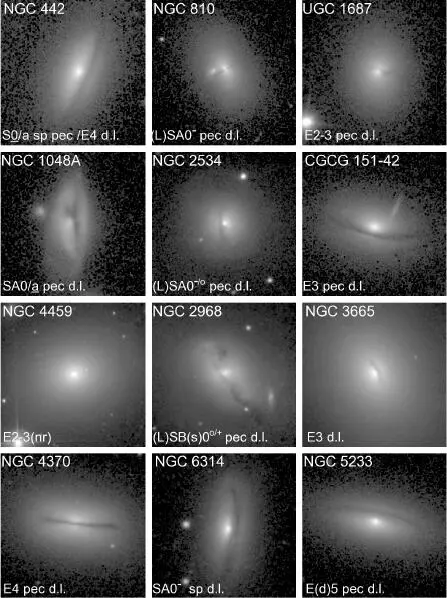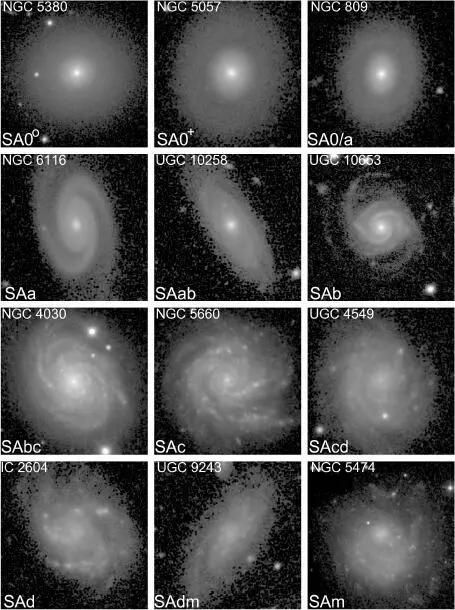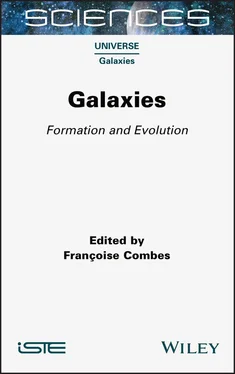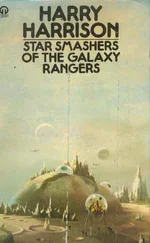Figure 1.8also includes the peculiar example of NGC 4459, where a small dusty ring, here recognized as a nuclear ring, is found. Although the presence of such a feature would normally warrant a classification of SA(r)0 +(Buta et al . 2007), the ring is clearly a small disk embedded in a much larger elliptical galaxy.

Figure 1.8. Twelve examples of dust-lane (d.l.) early-type galaxies, including ellipticals and S0s. Major axis (e.g. NGC 442, 4370 and 6314) and minor axis (e.g. NGC 810) cases are included
Luminosity profiles : de Vaucouleurs (1948) first recognized the well-known “  law” for ellipticals, and for a while it was generally thought that this characterized the luminosity distributions of all E galaxies. When the Sérsic (1968)
law” for ellipticals, and for a while it was generally thought that this characterized the luminosity distributions of all E galaxies. When the Sérsic (1968)  approach was used (e.g. Huang et al . 2013 and references therein), it became clear that n = 4 only characterized the more luminous ellipticals (see review by Graham 2013). Lower luminosity ellipticals have lower values of n . Other aspects of luminosity profiles include the distinction between “core Es”, which have a flat central profile, and “power-law Es”, which have a central cusp (Kormendy and Bender 1996).
approach was used (e.g. Huang et al . 2013 and references therein), it became clear that n = 4 only characterized the more luminous ellipticals (see review by Graham 2013). Lower luminosity ellipticals have lower values of n . Other aspects of luminosity profiles include the distinction between “core Es”, which have a flat central profile, and “power-law Es”, which have a central cusp (Kormendy and Bender 1996).
The fundamental plane of E galaxies : Elliptical galaxies are characterized by a well-defined interconnectedness of their physical parameters. In the three-dimensional space defined by the parameters Re , the effective radius that transmits half the total luminosity; Ie , the average surface brightness within this radius; and σo , the central velocity dispersion, an important characteristic emerges. The correlations between these three parameters of elliptical galaxies define what has come to be known as the “fundamental plane” (Kormendy and Djorgovski 1989). The plane tells us that larger E galaxies tend to have lower average surface brightness than smaller E galaxies, and that more luminous E galaxies have higher central velocity dispersion than do lower luminosity E galaxies.
The spiral structure of galaxies was discovered more than 170 years ago. The subtle patterns were first detected in 1845 with the world’s largest telescope at the time, the “Leviathan of Parsonstown” located in central Ireland. William Parsons, the Third Earl of Rosse, visually saw the spiral arms of the “Whirlpool Galaxy” M51 with his newly built 72-inch speculum metal reflector. In the parlance of 19th Century astronomy, M51 was called a “nebula”, not a galaxy, although the general view at the time was that most or all nebulae were distant systems of stars like the Milky Way (“Island Universe” hypothesis). Parsons built the Leviathan partly to test this idea. The discovery of spiral structure added mystique to the nebulae, and led to alternative ideas as to what the nebulae actually were. It would be nearly a century after Parsons’ discovery that any serious understanding of the nature of spiral structure would be achieved ( section 1.11).
Spiral galaxies are generally two-component systems consisting of a bulge and a disk. Although at one time bulges were thought to be generally less flattened components than disks, it is now clear that bulges include a mix of dissimilar structures, such as spheroidal “classical” bulges, highly flattened “pseudobulges” (Kormendy and Kennicutt 2004) and “boxy/peanut” bulges, the latter thought to be due to edge-on views of bars (e.g. Lutticke and Dettmar 1999).
The classification of spirals is generally based on a rough correlation between the degree of central concentration and the character of the spiral arms. Hubble had noticed that galaxies with tightly wrapped, relatively smooth arms tended to have bright central bulges, while galaxies having open, relatively patchy spiral arms tended to have very small bulges. Hubble (1926) called the former cases Sa galaxies and the latter cases Sc galaxies, with Sb galaxies being intermediate between the two types. This observation set the stage for galaxy classification for nearly a century. However, the correlation works best for non-barred galaxies. It is poorer for barred galaxies that, even in cases with smooth, tightly wrapped arms, can have very small bulges. An example is NGC 3351, type SBb, which has a very small bulge in the center of a bright nuclear ring (Buta et al . 2007). Because of such inconsistencies, Sandage (1961) advocated basing spiral stage classifications (i.e. Sa, Sb, etc.) mainly on the appearance of the spiral arms.
Figure 1.9shows a full CVRHS stage sequence for non-barred galaxies from stage S0° to stage Sm, that is, from the intermediate S0 stage ( Figure 1.3) to the latest stage on the spiral sequence. The spiral sequence begins with the stage S0/a, which is considered to be a transition type between S0s and spiral galaxies. Type S0/a is a legitimate type in the sense that it is easily recognized and the continuity that de Vaucouleurs envisioned seems well represented by the type. Nevertheless, this apparent continuity does not necessarily imply that all S0s are correctly placed in the Hubble (1936) “tuning fork”. The stage generally begins with pseudorings made of tightly wrapped spiral structure as in NGC 809. In the CVRHS classification, stage S0/a is closer to S0 than to Sa, while S0/a is closer to Sa than to S0.
The sequence for non-barred galaxies in Figure 1.9shows the rough correlation between central concentration and stage. Bulges are most prominent at stages Sbc and earlier, and are least prominent at stages Sc and later. The sequence shows well how arms are smooth at stage Sa and knotty, well-resolved, more open features at stage Sc. Intermediate stages are as well defined as regular stages: Sab galaxies often resemble Sa galaxies but with a greater degree of resolution into star-forming regions; Sbc galaxies typically have the bulge of an Sb galaxy in a disk with Sc arms; Scd is recognized as an Sc galaxy with only a trace of central concentration; and Sdm galaxies are typically bulge-less asymmetric systems with an offset bar and one spiral arm longer than the other. Similar underline stages (e.g. Sab. Scd) are used throughout the CVRHS sequence (de Vaucouleurs 1963).
Figure 1.10shows the same kind of stage sequence for barred galaxies. Initially, Hubble (1926) believed that non-barred galaxies were the “normal” form of spirals, with perhaps maybe 20% of the spirals being barred. He nevertheless envisioned barred spirals as falling on a sequence parallel to that of non-barred spirals. In the Hubble Atlas of Galaxies, Sandage (1961) smoothly connects non-barred and barred S0s with the non-barred and barred spiral prongs, respectively, which is also true for the VRHS and the CVRHS systems. The same kinds of types are recognizable among barred spirals as among non-barred spirals. However, Figure 1.10shows the small bulge effect in early-type barred spirals, an example being NGC 5610 whose smooth arms wrap into an outer pseudoring but whose bulge is no more prominent than that in an Sc galaxy.

Figure 1.9. A sequence of stages for non-barred galaxies in the VRHS/CVRHS system
Читать дальше


 law” for ellipticals, and for a while it was generally thought that this characterized the luminosity distributions of all E galaxies. When the Sérsic (1968)
law” for ellipticals, and for a while it was generally thought that this characterized the luminosity distributions of all E galaxies. When the Sérsic (1968)  approach was used (e.g. Huang et al . 2013 and references therein), it became clear that n = 4 only characterized the more luminous ellipticals (see review by Graham 2013). Lower luminosity ellipticals have lower values of n . Other aspects of luminosity profiles include the distinction between “core Es”, which have a flat central profile, and “power-law Es”, which have a central cusp (Kormendy and Bender 1996).
approach was used (e.g. Huang et al . 2013 and references therein), it became clear that n = 4 only characterized the more luminous ellipticals (see review by Graham 2013). Lower luminosity ellipticals have lower values of n . Other aspects of luminosity profiles include the distinction between “core Es”, which have a flat central profile, and “power-law Es”, which have a central cusp (Kormendy and Bender 1996).











